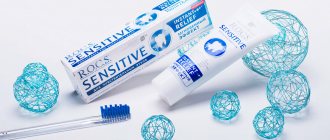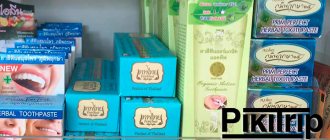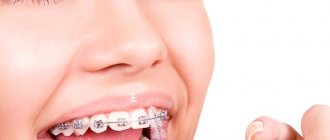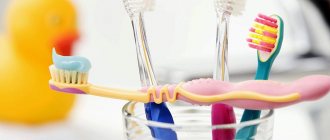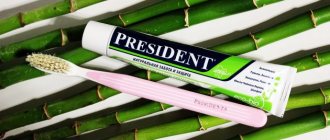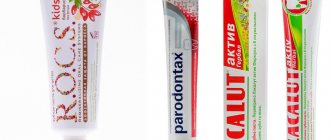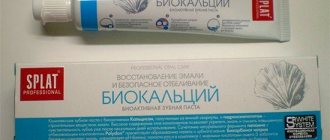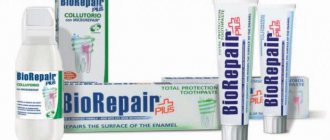Hydrogen peroxide
As mentioned above, this component is the main component of all teeth whitening products. Therefore, the question arises: why not use the experience of professionals in everyday life, especially since this remedy is in every first aid kit?
However, hydrogen peroxide should be used wisely, because... it has a rather aggressive effect on tooth enamel.
So, the following way to clean your teeth from nicotine plaque:
- because peroxide sold in pharmacies is quite concentrated for use on the delicate mucous membrane of the oral cavity - it should first be diluted with water in a 1:1 ratio and the oral cavity should be rinsed with this solution;
- before brushing your teeth, add 1-2 drops of hydrogen peroxide to your toothpaste - this will be enough;
- if you are interested in a more intense and noticeable result, you can mix peroxide with regular baking soda, in this case the soda will be an abrasive against plaque, and the peroxide will be its leavening agent;
- Using a cotton swab, this composition is applied to the teeth for a couple of minutes, then washed off by rinsing with water.
Important information! If you are tormented by the question of how to clean your teeth from nicotine plaque, eat sour apples more often. Due to their hardness and acid content, eating a couple of these fruits a day will give you a light cleansing effect due to the acid, and will additionally massage your gums due to the hard fibers.
What happens in the body
The most direct connection between smoking and the occurrence of plaque is that toxic tobacco smoke disrupts the balance of microflora and leads to the death of beneficial microorganisms, which are replaced by pathogenic bacteria - for example, fungi of the genus Candida, which cause candidiasis. The plaque has a white or grayish tint, and in appearance resembles cottage cheese.
But there are also more serious consequences of smoking. It is no secret that nicotine contributes to irritation of the mucous membranes of the oral cavity and digestive organs, constriction of blood vessels, suppression of the immune system, which can lead to the development of various diseases: gastritis, gastric ulcers, enteritis, impaired outflow of bile, cholecystitis, pancreatitis, etc. Sustained coating on the tongue may indicate their occurrence or exacerbation. So, when the liver is not functioning properly, it acquires a yellow tint, when bile stagnates, it becomes greenish, and in case of chronic stomach problems, it becomes brown. Moreover, the denser the plaque, the more intense the disease.
Types of raid
Plaque formation is a normal process that occurs constantly. At the first stage, it even performs protective functions, protecting the enamel from external factors.
White plaque is a thin film that appears within a couple of hours after brushing your teeth. If we maintain hygiene and do not give up solid food - carrots, strong apples, crackers - part of the plaque is cleaned off. What remains is the one that got into the interdental spaces.
You can remove it with floss at home. If this is not done, it gradually hardens, mineralizes, turning into tartar. It is impossible to whiten teeth with such deposits at home. Requires professional cleaning. Smokers' teeth are particularly susceptible to becoming overgrown with such fossils.
Signs and consequences of a raid
Plaque does not always have a white tint. Color varies depending on circumstances. Let's see what plaque happens and why it occurs:
- Yellow. The color is due to frequent consumption of sweets. Microparticles of food penetrate deep into the white plaque and change its hue. Those who love buns and sweets often experience such a raid. Cigarettes have the same effect: the smoker’s teeth are almost always yellow. Lovers of strong coffee and steeply brewed black tea also often suffer from such a raid.
- Grey. The reason is enamel hypoplasia. The disease needs to be treated by a dentist. It is easy to deal with it using modern methods.
- Brown. This color is worn by experienced smokers. First, a yellow film appears on the crowns, then it darkens. The result: a permanent, dark-colored coating that can only be removed with hygienic cleaning and bleaching. Another reason for brown plaque is metabolic diseases and gastrointestinal tract diseases. Sometimes the crowns that cover dilapidated teeth are made with an admixture of copper - then the plaque takes on a brownish tint.
- Green. This color is possible for children. Sometimes adults also suffer due to the destruction of enamel.
- Black. With such a plaque, doctors recommend checking the condition of the biliary tract, and also eliminating the presence of parasites in the body. Plaque is removed in the dentist's office.
We invite you to read: A yellow coating appears on the tongue: TOP 5 reasons in adults
Whatever the color of the coating, if it is not removed, it mineralizes. After 10 days it is already hard tartar. Whitening pastes and other home remedies will not cope with it.
There are 2 types of stone:
- supragingival (in open areas of teeth);
- subgingival (in the pocket, on the neck of the tooth).
Fresh supragingival plaque can be removed with a toothbrush, but subgingival plaque can only be cleaned using professional treatment methods.
Removing smoker's plaque
Family Dentistry provides professional teeth cleaning. On the recommendation of a doctor, modern methods and equipment are used to remove plaque from tobacco smoke.
The chemical method is the application of chemicals to the surface of the teeth. The solution contains acids that soften the density for the next stage - mechanical (hardware) cleaning.
Hardware cleaning:
- Cleansing using ultrasound. The deposits are knocked down using an ultrasonic wave from a scaler - a special device for removing hard dental deposits. The curved nozzle of the device reaches even hard-to-reach areas of the dentition. The technique only gets rid of massive deposits, so it is combined with another modern technology - Air-Flow.
- The nozzle of the Air-Flow device delivers a mixture of air, water and powder to the tooth surface. The soft and pigmented plaque is removed and the enamel is polished.
- The final stage of getting rid of dental plaque is grinding the surface using brushes of varying degrees of hardness and polishing paste. Sometimes silicone cups are used to achieve the desired effect. The effect is immediately noticeable.
- Professional teeth cleaning can cause slight discomfort, so an anesthetic gel is used, and in case of severe sensitivity, injection anesthesia is used. With constant consumption of nicotine, professional hygiene is recommended to be carried out 2 times a year to prevent smoker plaque and other diseases.
Daily brushing of teeth with paste, brush and floss is another measure to prevent and combat unwanted darkening of teeth.
Do electronic cigarettes make teeth yellow?
As for electronic cigarettes, smoking them does not cause residue.
For reference! This is the safest form of smoking today.
From this video you will learn about effective ways to get rid of plaque on teeth:
Smoking is undoubtedly a bad habit, it is better to get rid of it.
But if this cannot be done, preventive measures should be taken to avoid the formation of plaque.
When your teeth do turn yellow, there is no need to hesitate to go to the dentist, although in the early stages of yellowing you can use folk remedies.
How smoking affects teeth
Cigarette smoke contains about 4,000 different substances. More than 200 of them pose a serious threat to human health (nicotine, tobacco tar, carbon monoxide and others). Smoking causes persistent vasoconstriction, which disrupts the nutrition of tissues and organs.
The aging process accelerates, which negatively affects the skin, hair, bones, vision, and teeth. The latter become covered with a characteristic coating, are affected by caries, become fragile and darken.
Nicotine destroys dentin, which protects the tooth pulp from harmful bacteria. As a result, infections settle in the oral cavity. The activity of pathogenic microorganisms increases the formation of plaque, which causes bad breath.
Smokers often have inflamed and bleeding gums. Often the problem becomes serious and leads to the development of gingivitis and periodontal disease. According to statistics, 4 out of 10 people who smoke completely lose their teeth by the age of 65, while among the rest this figure is half as much.
We suggest that you familiarize yourself with Teething Fever in Children
Diseases that can be caused by nicotine plaque
A cosmetic defect is far from the biggest nuisance; an abundance of dental plaque contributes to the development of dental diseases:
- Bacteria “living” in deposits produce toxins that not only cause bad breath, but also negatively affect the functioning of the gastrointestinal tract.
- Over time, deposits harden and mineralize, leading to the formation of tartar.
- Dental plaque is a fertile environment for the growth of bacteria. This leads to inflammatory processes in the oral cavity. Smokers are more likely to have inflamed and bleeding gums.
- Cigarette plaque provokes the development of caries.
Whitening pastes, strips, gels
Entire lines of products have been developed especially for smokers to help keep teeth white and remove nicotine plaque. These are special toothpastes, compositions for application to teeth, quick strips. How do they differ from each other:
- Whitening pastes. They are conventionally divided into two types: with abrasive particles (based on soda or chalk), with chemical elements (based on hydrogen peroxide, urea). The former simply remove plaque, the latter whiten teeth, but thin the enamel. Such pastes alternate with regular ones.
- Creams and gels. Most of these products require the use of an additional accessory - a mouth guard, which is made individually based on impressions or purchased at a pharmacy. The mouth guard allows you to securely fix the gel on your teeth and ensure its long-lasting effect for several hours. For bleaching, compositions containing a solution of either hydrogen or urea peroxide are used. The visible effect is noticeable after 2-3 weeks, the whiteness is permanent.
- Whitening strips. They are glued to teeth and quickly lighten tooth enamel thanks to special impregnation. The downside is insufficient access to the sides and back of the teeth, which is why whitening looks uneven with frequent use.
It is advisable to select one or another remedy together with the dentist, based on the general condition of the teeth. In most cases, after professional services are provided, the use of a special toothpaste is sufficient to maintain the effect. Gels and strips can be used as an alternative to machine whitening or to quickly improve the appearance of teeth.
What is the best whitening toothpaste for smokers?
It is worth understanding that plaque and tartar do not form in one day. best teeth whitening toothpaste will not help completely remove years of yellow plaque from smoking . Only hardware techniques and substances that soften tooth enamel help with this. For example, carbamide peroxides make enamel more porous, after which atomic oxygen easily removes dark deposits and yellow pigments.
However, along with pigmentation, mineral substances are also removed, and porous enamel is even more susceptible to the effects of dyes. Therefore, often after hardware whitening, after only a short amount of time, teeth darken even more if you do not follow a “white” diet.
Uses of baking soda
The whitening effect of using soda is due to the mechanical effect on tooth enamel. The powder works as an abrasive, gently cleaning teeth from plaque.
In case of severe contamination, baking soda is mixed with water, brought to the consistency of toothpaste, and applied to the darkened areas for 10 minutes. Then rinse the mixture with water and brush your teeth as usual. If the nicotine plaque is pale, add a pinch of baking soda to the toothpaste when brushing about once a week.
Attention! Getting baking soda on the gums can cause damage to the mucous membrane and bleeding.
Preventing smoker's plaque
In order to reduce the likelihood of smoker plaque forming on your teeth in the future, it is worth systematically reducing the number of cigarettes you smoke per day.
For constant oral hygiene, it is recommended to use special products created specifically for those who smoke. Preventive toothpastes, gels and rinses help remove bacteria and additionally have a deodorizing effect.
If a person continues to abuse tobacco, brushes his teeth irregularly or incorrectly, or does not go to a hygienist for preventive maintenance, smoker’s plaque on his teeth will reappear. Therefore, if you cannot give up cigarettes, take care of high quality hygiene.
You can remove smoker's plaque at the Doka-Dent clinic in Moscow. To do this, sign up for the procedure on the website or by phone.
Causes and features of plaque formation
The characteristic tobacco layer on the teeth of smokers appears gradually. First, the formation of white plaque increases, which in all people accumulates during sleep and is easily cleaned off with a toothbrush. Then the deposits gradually darken, starting from the cervical areas.
The color of the plaque varies from light yellow to dark brown and black. Over time, the formations harden, they turn into stones and constantly irritate the gums.
As for the causes of nicotine plaque, they consist in the deposition of microparticles of nicotine and various resins on tooth enamel. The interaction of salivary proteins and combustion products leads to the deposition of cadmium sulfate. Additionally, the formation of this layer is provoked by an infectious environment and the altered composition of smokers’ saliva.
Smoker's dental plaque - causes of formation
For people who smoke, tobacco smoke has a direct effect on their teeth. Nicotine and other substances contained in smoke (phenol derivatives, tar) partially settle on the enamel, are absorbed into it and change its color - it first becomes light brown, and then dark brown.
The color changes most strongly in the most vulnerable places - in the root zone, in the area of the so-called neck, where the crown turns into the roots. This is explained by the fact that in this area there is no chewing load and no self-cleaning process, unlike those areas with which a person chews food.
Important! Cigarette lovers who neglect basic oral hygiene (using a toothbrush) develop smoker plaque many times faster!
The interaction of components of cigarette smoke with normal dental plaque leads to more intense darkening.
Professional whitening at the dentist
When you can’t get rid of cigarette stains at home, you can resort to the services of specialists.
Modern dentistry allows you to quickly, efficiently, and most importantly, win-win solve the problem of smokers.
What whitening methods exist:
- Professional cleaning. Thanks to innovative technologies and special equipment, even the darkest nicotine stains noticeably lighten, tartar and other contaminants are removed. Cleaning can be mechanical, laser and ultrasonic. Polishing completes the procedure. The effect lasts for about six months.
- Chemical bleaching. If the discoloration is caused not only by nicotine plaque, but also by darkening of the dentin, cleaning will not be enough. In this case, the use of a special gel based on hydrogen peroxide or urea is indicated. Application is carried out in the dental office. The gel works either on its own or under the influence of catalysts (light from an ultraviolet or halogen lamp, laser beam).
We invite you to familiarize yourself with Dental X-ray – types and interpretation. How often can an x-ray be taken and what does it show?
These techniques can be used individually or combined. The best way to get rid of nicotine plaque is to use a chemical preparation followed by grinding and fluoridation of the enamel.
Recommendations from Dr. Zubastic
I can only give the simplest advice: quit smoking.
There are many traditional methods of teeth whitening, and dentistry does not stand still, but no matter how much you clean off plaque, it will constantly appear, coupled with bad breath, forcing you to spend considerable sums on professional whitening. Throw away the cigarette: it has never brought any benefit to anyone, but there are a great many victims of it.
If the above arguments do not convince you, watch the video. It will help you quit smoking forever.
activated carbon, White deposits, Yellow deposits, Green deposits, Brown deposits, lemon, Smoker deposits, Cigarette deposits, bleaching, hydrogen peroxide, Problems, Gray deposits, soda, Black deposits
Methods for removing plaque
Those smokers who do not know how smoking affects their teeth may believe that dental health problems are caused by some other reasons. And having realized that this phenomenon is caused by a bad habit, many mistakenly believe that it will not be possible to get rid of the yellow plaque.
In case of advanced plaque that has acquired a brown or black tint, it is better to consult a dentist, because traditional medicine is unlikely to cope with this. But if the enamel has undergone minor changes in color, then it is quite possible to cope with the problem yourself. So how to remove plaque from cigarettes on teeth at home?
The danger of untimely treatment and plaque removal
The appearance of cigarette residue cannot be ignored! Especially if it is accompanied by gingivitis, bad breath and bleeding gums. Failure to promptly seek help and remove plaque will lead to the progression of gingivitis, which will cause periodontal disease - periodontitis. In turn, periodontitis is accompanied by mobility of the dentition, which can ultimately result in tooth loss.
We should not forget about such a dental problem as caries, the main reason for the development of which is dental plaque. The pathogenic microorganisms that “live” in it, day after day, destroy not only the enamel, but also the hard tissues of the tooth, which will ultimately lead to its loss.
Characteristics of plaque on teeth from smoking
As already mentioned, when smoking cigarettes, plaque forms on the teeth. He can be:
- yellow;
- brown;
- black;
- white;
- green.
Note! The safest is white plaque. It can form very quickly on the surface of teeth. It appears, as a rule, due to the consumption of certain foods, as well as under the influence of microbes and bacteria that multiply on the teeth.
How to get rid of white plaque on teeth from smoking? It is easy to clean teeth from such plaque by regular brushing with a toothbrush. If such plaque is removed in time, it will not harm tooth enamel.
A green coating is considered a rare occurrence. The reason for its appearance may be the presence of a fungal infection of the oral cavity or a violation of the pellicle.
Plaque, which has a yellow or brown tint, occurs due to pigmentation of the teeth, which is caused by smoking and frequent consumption of coffee or strong tea. When thinking about how to get rid of cigarette plaque on your teeth, it is important to understand that it is difficult to cope with this problem on your own. Therefore, if such plaque appears, it is recommended to contact your dentist for professional cleaning.
An advanced form of pigmentation is the appearance of a black plaque, which previously had a lighter shade.
How to clean teeth from tobacco plaque?
There are two ways to whiten teeth yellowed from smoking: seek help from a dentist or use home remedies.
Cleaning with professional methods
Dental clinics use the following cleaning methods:
- Ultrasonic . The procedure is painless and is performed using an ultrasound machine. The waves help remove accumulations, both from the enamel and under the gum. The hardened tartar is crushed into pieces and then washed off. The procedure does not take much time, about 30-40 minutes.
- Air Flow . Cleaning is carried out through a special apparatus that supplies a stream of air with water and special microparticles, as shown in the photo on the right.
- Dry cleaning . It is used less frequently, only in cases where ultrasonic or AirFlow techniques are powerless. Quite aggressive chemicals are used and there is a risk of damage to the enamel.
- Laser cleaning . An expensive procedure, but very effective. In addition to cleansing deposits and stone, it can relieve inflammation of the mucous membrane and does not harm the enamel. During the cleaning process, the color of the enamel also changes. To achieve a positive result, several sessions may be required; the cost of one starts from 3,000 rubles. and sometimes reaches very significant amounts.
To achieve greater efficiency, a specialist may recommend resorting to several types of cleaning (combined cleaning).
The professional cleaning procedure allows you to forget about the brown coating, however, not for long. Smokers should repeat the procedure twice a year. The approximate cost of professional teeth cleaning using an ultrasonic device, as well as the Air Flow method, will be 100-150 rubles. for one tooth.
Professional cleaning includes several stages:
- Removing plaque and stone.
- Polishing tooth enamel. This mandatory step allows you to make the enamel smooth, which will make it difficult for deposits to “stick” again.
- Coating teeth with fluoride varnish. The procedure is not mandatory, but very useful: it strengthens the enamel, relieves hypersensitivity, and helps prevent caries.
Despite all the advantages of professional cleaning, its use in some cases is not permissible, namely:
- adolescence and childhood;
- pregnancy;
- lactation;
- herpes;
- HIV;
- hepatitis;
- dental hypersensitivity;
- heart diseases.
How to whiten teeth at home?
It is possible to remove stains from smoking at home, however, this process is very lengthy.
Among the large number of folk methods, there are very often recipes for whitening tooth enamel with soda, activated carbon and hydrogen peroxide. These methods are very aggressive and highly abrasive. Bleaching with such components is dangerous and fraught with serious consequences: destruction of enamel, caries and burns of the mucous membrane.
The most widespread among gentle methods of teeth whitening are:
- Lemon . It is enough to wipe your teeth with a small piece of citrus no more than 2 times a week. With strongly rooted plaque, the method is ineffective.
- Tea tree oil . Along with cleansing the enamel, it also has a disinfecting effect. After brushing your teeth, you need to put a few drops of oil on your toothbrush and “brush” your teeth with the oil. Rinse your mouth with water and lemon juice. Slight numbness after the procedure is acceptable.
- Wood ash . You can add ash to toothpaste or use it on its own.
- Honey _ Able to soften plaque and has an antibacterial effect. 1 tablespoon per glass of water is enough. Rinse daily 3-4 times a day. Repeat the procedure for a month.
- Strawberry . It is believed that the natural components contained in the berry help lighten the enamel. It is enough to wipe your teeth with berries or brush your teeth with strawberry pulp.
In addition to folk remedies, there are also cosmetic ways to whiten teeth at home. The most popular among smokers are:
- Whitening pens or strips . The main active ingredient is hydrogen peroxide in a 2-12 percent solution. It is extremely important not to exceed the permissible number of procedures so as not to thin the enamel.
- Mouthguards . A very convenient and popular home method. You will need to contact a specialist to make an impression; the rest of the procedure can be done at home. The tray is filled with whitening gel. The White Light device, which includes a silicone mouth guard, gel and a light device, has become especially popular.
- Whitening toothpastes . Their whitening property is due to the fact that most of them contain baking soda. Such pastes are not recommended for continuous use due to the risk of thinning the enamel. The most common are Lacalut White and Splat.
- Gels . They can lighten the enamel a couple of tones. The active ingredient is hydrogen peroxide or carbamide. The first is the most effective, but not safe. The most popular gels are from manufacturers Rocs, Global White and Colgate.
- Sonic brushes. Able to work in accelerated mode, resulting in more effective cleaning.


